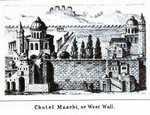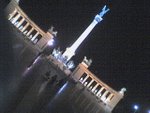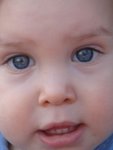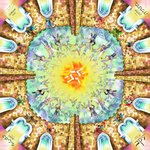A Gólemet Jehuda Lőw rabbi (a prágai "Maharal") hozta létre a 16. században. Abban az időben a prágai zsidók rendszeres antiszemita zavargásoknak illteve pogromoknak voltak kitéve, így hosszú évekig rettegésben kellett élniük. Lőw rabbi ezért elhatározta, hogy a Kabbalah titkos bölcsességének felhasználásával megalkot a zsidók védelmére egy gólemet, azaz egy agyagból készült óriást, amelynek nem volt az emberekéhez hasonló lelke, azonban képes volt ellátni a rábízott feladatokat. A Gólem homlokára az "emet" azaz "igazság" szó volt írva.
A Gólem teljesítette a rabbi parancsait, és gondoskodott a prágai zsidó negyed védelméről. Idővel azonban az emberek félni kezdtek tőle. A város vezetősége megígérte a rabbinak, hogy ha elpusztítja a Gólemet,

cserébe nyugodt életet biztosítanak a helybeli zsidóknak. A rabbi beleegyezett. A Gólem homlokán lévő felirat első betűjét eltávolította, így "emet" helyett a "met" szó maradt, melynek jelentése "halott", így a Gólemből eltávozott az élet.
Egy legenda szerint Lőw rabbi fia később újra életet lehelt a Gólembe, aki talán még mindig védelmezi Prágát.
 My dear friend, Rut called my attention to the resemblance between the picture in
My dear friend, Rut called my attention to the resemblance between the picture in the previous post, the one made on the island, the beautiful one that I called "Young woman on the grass", and the Golem of Prague.
In the 16th century, during the reign of Rudolf II, great Rabbi named Rabbi Yudah Loew lived in Prague ("The Maharal" of Prague). During that time, the Jewish people of Prague were being attacked and lived their lives in fear. Rabbi Loew decided to protect the Jews against pogroms by creating the Golem, a giant who according to the Kabbalah could be made of clay from the banks of the Vltava. Following the prescribed rituals, the Rabbi built the Golem and made him come to life by reciting a special incantation in Hebrew. The word "emet", meaning "truth", was placed on the Golem's forehead.
The Golem would obey the Rabbi's every order and would help and protect the people of the Jewish Ghetto. However, as he grew bigger, he also started spreading fear. Rabbi Loew was promised that the violence against the Jews would stop if the Golem was destroyed. The Rabbi agreed. By removing the first letter from the word "emet", thus changing it to "met" (meaning "death"), life was taken out of the Golem. According to a legend, the Golem was brought back to life by Rabbi Loew's son, and may still be protecting Prague today.



















